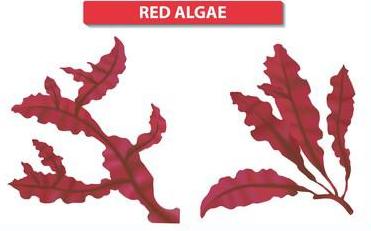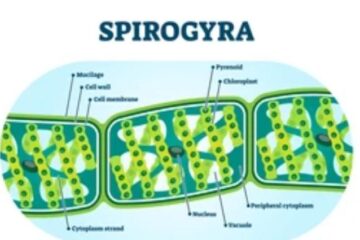Introduction :
Welcome to the captivating world of red algae, where a kaleidoscope of vibrant colors and astonishing biodiversity awaits exploration! Amidst the vast oceans, these extraordinary organisms, also known as Rhodophyta, reign as one of the oldest and most enigmatic groups of algae known to humankind. With their remarkable adaptability to various marine environments and a vast array of mesmerizing hues, red algae have charmed scientists, artists, and nature enthusiasts alike for centuries.
Unlike their green and brown counterparts, red algae proudly showcase their brilliance through a stunning array of reds, pinks, purples, and even blues, captivating all who behold them beneath the ocean’s surface. From the microscopic, delicate filaments that paint the rocky intertidal zones to the sprawling, majestic seaweeds that sway gently in the currents, red algae have carved out a unique and essential niche in marine ecosystems.
Beyond their sheer beauty, red algae possess remarkable ecological significance, acting as crucial providers of shelter and sustenance for a myriad of marine organisms. They possess extraordinary adaptations, allowing them to thrive in various depths, temperatures, and salinity levels, making them resilient and resourceful inhabitants of our vast aquatic world.
Join us on a captivating journey to uncover the secrets and wonders of these remarkable marine gems. Let us delve into the captivating history, intricate structures, and essential ecological roles that red algae play in our delicate marine ecosystems. Prepare to be awestruck by the resilience and elegance of these ancient marine conquerors, as we unveil the fascinating world of red algae, an extraordinary tapestry of life hidden beneath the waves.
Definition
Red algae, also known as Rhodophyta, are a diverse group of ancient photosynthetic organisms that primarily inhabit marine environments. Their distinctive reddish color results from the presence of the pigment phycoerythrin, which complements chlorophyll in their photosynthetic process. Red algae exhibit a wide range of forms, from small unicellular species to large, multicellular seaweeds.

Red Algae
Red algae (Rhodophyta) have a widespread distribution and can be found in various marine and freshwater habitats worldwide. Their adaptability to different environmental conditions allows them to thrive in diverse ecosystems. Here are some key points about the distribution and habitat of red algae:
- Marine Environments: Red algae are predominantly marine organisms, and they are most abundant in saltwater habitats. They can be found in all oceans, from polar regions to tropical and subtropical waters. Some species even inhabit extreme environments, such as the intertidal zone and deep-sea areas.
- Intertidal Zones: Many red algae species are well-suited to intertidal zones, where the ocean meets the land. They can tolerate exposure to air during low tide and are resilient to fluctuations in salinity and temperature.
- Rocky Shores: Red algae often colonize rocky shorelines, where they attach themselves to rocks, shells, and other hard substrates. These coastal habitats provide a stable platform for red algae growth.
- Coral Reefs: Some red algae, known as coralline algae (order Corallinales), play a significant role in building and stabilizing coral reefs. They secrete calcium carbonate into their cell walls, contributing to the reef’s structure and acting as cementing agents for coral fragments.
- Seagrass Meadows: Red algae can be found in seagrass meadows, where they coexist with seagrasses and contribute to the overall biodiversity and productivity of these ecosystems.
- Kelp Forests: Although most red algae are relatively small, some species, such as the giant kelp (Macrocystis pyrifera), can grow to impressive sizes and form dense underwater forests known as kelp forests. These habitats provide crucial shelter and food for numerous marine species.
- Deep-Sea Habitats: Red algae exhibit adaptability to various depths, and some species can be found in the deeper regions of the ocean. They play a role in the composition of deep-sea benthic communities.
- Freshwater Habitats: While the majority of red algae are marine, some species have adapted to freshwater environments, such as lakes, rivers, and streams. These freshwater red algae are often found in the intertidal zone and other shallow areas with relatively stable water conditions.
- Epiphytic Habitats: Red algae can grow as epiphytes on other marine organisms, such as seagrasses, algae, and even other red algae. This epiphytic growth allows them to take advantage of available light and nutrients.
- Extreme Environments: Certain red algae species have adapted to extreme environments, such as hot springs and hypersaline areas, where other algae may not survive due to extreme temperatures or salinity.
Overall, the distribution of red algae is vast and encompasses a wide range of habitats, making them important contributors to marine and freshwater ecosystems worldwide. Their ecological adaptability and unique characteristics have allowed them to flourish in various environments, playing essential roles in marine biodiversity and ecosystem stability.

Taxonomy and classification
Taxonomy and classification play a crucial role in understanding the diversity and evolutionary relationships of organisms, including red algae (Rhodophyta). In the scientific community, the classification system used is based on the principles of taxonomy, which arranges living organisms into hierarchical groups based on their evolutionary history and shared characteristics. Here’s an overview of the taxonomy and classification of red algae:

Kingdom: Plantae (or Protista)
Red algae are classified within the Kingdom Plantae or Kingdom Protista, depending on the classification system used. The Plantae kingdom includes plants and some algae, while the Protista kingdom encompasses various eukaryotic organisms that do not fit neatly into other kingdoms.
Phylum: Rhodophyta
Red algae belong to the phylum Rhodophyta, which comprises a diverse group of mostly marine algae. The name “Rhodophyta” is derived from the Greek words “rhodos” (meaning “red”) and “phyton” (meaning “plant”), referring to the prominent red coloration observed in many species due to the presence of phycoerythrin.
Class: Florideophyceae, Bangiophyceae, and Compsopogonophyceae
Within the phylum Rhodophyta, red algae are further classified into three main classes based on their life history and reproductive features:
- Florideophyceae: This is the largest and most diverse class of red algae, containing the majority of known species. It includes various forms, ranging from microscopic, unicellular species to larger, multicellular seaweeds. Examples include dulse (Palmaria palmata) and Irish moss (Chondrus crispus).
- Bangiophyceae: This class includes small, simple red algae, often found in freshwater or intertidal marine environments. They are typically unicellular or filamentous. An example is the genus Bangia.
- Compsopogonophyceae: This is a relatively small class of red algae, comprising mostly filamentous forms. They are often found in tropical or subtropical regions.
Order, Family, and Genus:
Within each class, red algae are further organized into orders, families, and genera based on more specific characteristics. These groupings allow scientists to study and compare related species more effectively.
Species:
Finally, each unique type of red algae is classified as a specific species, indicated by its scientific name, which consists of the genus name followed by the species name. For example, the species of the red alga Chondrus crispus is represented as Chondrus crispus.
It is essential to note that the classification of red algae, like all organisms, may be subject to revisions and updates as new research and discoveries are made. Advances in molecular techniques and genetic analyses have contributed to a deeper understanding of the evolutionary relationships within the group, leading to potential changes in their taxonomic classifications over time.
Human Uses And Applications:
Red algae (Rhodophyta) have a variety of human uses and applications due to their unique properties and biochemical composition. Some of the key uses and applications of red algae include:
- Food Industry: Several species of red algae are used as a source of food in various cultures around the world. Examples include nori (Pyropia spp.) used in Japanese cuisine for sushi rolls, dulse (Palmaria palmata) in Northern European dishes, and laver (Porphyra spp.) in Korean and Welsh cuisine. These edible red algae are rich in nutrients, including vitamins, minerals, and proteins, making them valuable components of a balanced diet.
- Agar Production: Red algae belonging to the genera Gracilaria and Gelidium are used for agar production. Agar is a gelatinous substance derived from red algae and is widely used as a gelling agent, stabilizer, and thickener in the food, pharmaceutical, and cosmetic industries. It is utilized in various products, including desserts, jams, microbial culture media, and dental impression materials.
- Carrageenan: Carrageenan, extracted from red algae like Irish moss (Chondrus crispus) and other species, is a versatile hydrocolloid used in the food industry. It acts as a thickener, stabilizer, and emulsifier in a wide range of food products, such as dairy items, desserts, and processed meats.
- Biotechnology and Research: Red algae produce various bioactive compounds with potential applications in biotechnology and medical research. These compounds include antioxidants, anti-inflammatory agents, and antimicrobial substances, among others. Scientists are studying red algae to harness these bioactive compounds for pharmaceuticals, nutraceuticals, and other medical applications.
- Cosmetics and Personal Care: Red algae-derived extracts are increasingly used in cosmetic and personal care products due to their moisturizing, soothing, and anti-aging properties. They can be found in skincare products, such as creams, lotions, and masks, as well as in hair care products.
- Aquaculture and Agriculture: Some red algae, particularly species of Gracilaria, are cultivated for purposes beyond agar production. They are used in integrated aquaculture systems as a nutrient-rich feed for fish and shellfish, contributing to sustainable aquaculture practices. Additionally, red algae can be used as fertilizers or soil conditioners in agriculture.
- Environmental Applications: Red algae play a role in environmental remediation by helping to purify polluted waters and absorb heavy metals and other pollutants. Some species also contribute to the stabilization and reinforcement of coastal ecosystems, such as coral reefs.
- Art and Craft: The beautiful and distinct colors of red algae have been used in traditional arts and crafts. In some cultures, red algae have been used to dye fabrics, create pigments for painting, and as decorative elements.
Overall, red algae offer a wide range of valuable applications in various industries, contributing to the economy, human health, and sustainable practices. Continued research and innovation are likely to unveil even more potential uses for these versatile marine organisms in the future.
Examples:
Red algae (Rhodophyta) encompass a vast and diverse group of organisms with numerous species found in various marine and freshwater habitats worldwide. Here are some examples of red algae:

- Nori (Pyropia spp.): Nori is a widely known and commercially important red algae used in Asian cuisine, particularly in the preparation of sushi rolls and other dishes. It has a thin, delicate texture and imparts a subtle umami flavor to the food.
- Irish Moss (Chondrus crispus): Irish moss, also known as carrageen moss, is a common red algae found in the cold waters of the Atlantic Ocean. It is used in food and cosmetic industries as a source of carrageenan, a gelling agent and thickener.
- Dulse (Palmaria palmata): Dulse is another edible red alga, popular in northern Europe and Atlantic coastal regions. It is enjoyed as a nutritious snack and often used in soups, salads, and other dishes.
- Gracilaria spp.: Gracilaria species are red algae commonly found in tropical and subtropical regions. Some species are cultivated for their economic value, as they serve as a source of agar, a gelatinous substance used in scientific research and various applications in the food and pharmaceutical industries.
- Gelidium spp.: Gelidium species are red algae also used for agar production. They are found in marine environments worldwide and contribute significantly to the agar industry.
- Coralline Algae (Corallinales): Coralline algae are a group of red algae that play essential ecological roles in coral reefs and rocky marine habitats. They deposit calcium carbonate in their cell walls, contributing to reef structure and stability.
- Porphyra spp.: Porphyra species, like nori, are used in Japanese cuisine and are cultivated for commercial purposes. They are also known as “laver” and are used in various dishes.
- Chondracanthus spp.: Chondracanthus species are commonly known as “Turkish towel” or “carpet weed” due to their flat, sheet-like appearance. They are found in rocky intertidal zones and contribute to the biodiversity of these ecosystems.
- Polysiphonia spp.: Polysiphonia is a genus of red algae with filamentous structures. They are found in a wide range of marine environments and are an essential component of coastal ecosystems.
- Palmaria spp.: Palmaria species are found in both temperate and cold waters and are used as food and in traditional medicine in some cultures.
These examples represent only a fraction of the vast diversity of red algae found worldwide. Each species plays a unique role in marine ecosystems and may have economic, ecological, or cultural significance in different regions.
Conclusion:
In the mesmerizing world of red algae, nature unveils its artistic masterpiece beneath the ocean’s surface. These ancient organisms, adorned in breathtaking hues of red, pink, and purple, have not only survived the test of time but have thrived, adapting to the ever-changing marine environments with grace and resilience.
As we conclude our exploration of red algae, we are left in awe of the profound ecological significance they hold. From sheltering vibrant coral reefs to forming enchanting kelp forests, red algae weave a tapestry of life that sustains countless marine species and balances the delicate harmony of our oceans.
Beyond their ecological contributions, red algae have gracefully extended their embrace to humanity. From nourishing our bodies with wholesome foods like nori to providing us with agar for scientific advancement, they have become invaluable partners in human progress and well-being.
Yet, it is their inherent mysteries that continue to captivate our scientific spirit. Hidden within their cellular secrets are a myriad of bioactive compounds, offering potential cures for diseases and inspiration for sustainable technologies. As we delve deeper into their molecular realm, red algae offer glimpses of a future where humanity harmonizes with nature in pursuit of greater understanding and prosperity.
In our pursuit of knowledge and admiration for red algae, let us remain steadfast stewards of our oceans, preserving these ancient wonders and safeguarding the intricate ecosystems they nurture. Together, as guardians of this underwater symphony, we embark on a journey to protect and cherish the red algae, ensuring that their vibrant presence graces our planet for generations to come.
In the end, red algae stand as an eternal testament to the magnificence of life on Earth, reminding us that even in the hidden depths, beauty thrives, and the promise of discovery dances on every wave. Let us celebrate these captivating marine conquerors and their boundless potential as we venture into the future, hand in hand with the wonders of the red algae.
Question /Answers
Q#1: What makes red algae appear red, and how does this pigment impact their ecological role?
Answer: Red algae appear red due to the presence of a pigment called phycoerythrin. This pigment masks the green color of chlorophyll during photosynthesis, giving them their distinct reddish hues. Phycoerythrin allows red algae to efficiently absorb light in deeper waters, enabling them to thrive in lower light conditions. This adaptation contributes to their ecological role as important primary producers, providing food and shelter for various marine organisms in deeper ocean regions.
Q#2: How do red algae contribute to the formation and stabilization of coral reefs?
Answer: Red algae, specifically the coralline algae from the order Corallinales, play a vital role in the formation and stabilization of coral reefs. These algae secrete calcium carbonate into their cell walls, acting as cementing agents for coral fragments and helping to build the reef’s structure. The calcium carbonate deposits of coralline algae contribute to the reef’s overall structural integrity, providing a solid foundation for corals and other reef organisms.
Q#3: What are the potential applications of red algae in biotechnology and medical research?
Answer: Red algae produce various bioactive compounds with potential applications in biotechnology and medical research. These compounds, such as antioxidants, anti-inflammatory agents, and antimicrobial substances, hold promise in pharmaceuticals and nutraceuticals. They may offer treatments for various health conditions, including inflammation-related diseases and certain infections. Additionally, red algae-derived compounds are being investigated for their potential use in skincare products and regenerative medicine.
Q#4: How are red algae cultivated for commercial uses like agar production?
Answer: Red algae species, particularly Gracilaria and Gelidium, are cultivated in aquaculture settings for agar production. The cultivation process involves growing the algae in controlled environments such as seawater tanks or ponds. Under proper conditions, the algae rapidly reproduce, and after harvesting, they undergo extraction processes to obtain agar. This sustainable cultivation method ensures a steady supply of agar, a valuable ingredient used in food, pharmaceuticals, and research applications.
Q#5: How do red algae contribute to the environmental sustainability of coastal ecosystems?
Answer: Red algae play a vital role in coastal ecosystems by providing essential habitats and acting as nutrient recyclers. They create microenvironments for diverse marine species, offering shelter and breeding grounds for various fish, invertebrates, and microorganisms. Additionally, red algae help purify polluted waters by absorbing excess nutrients, heavy metals, and other pollutants, contributing to the environmental sustainability of coastal regions.




